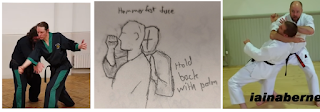 |
| Source: Kukkiwon |
Turns out I knew Cheonkwon incorrectly.
I had been using the instructions from the taekwondo wiki, which states that step 20a (the first slapping block) is an inward block.
I never questioned this instruction because I figured the application was obvious. Since the low guarding block may be used to pass outside the opponent's arm, one can then shuffle behind the opponent and perform a hammerfist while pressing in their back (the first slap). Then palm strike their face (second slap), grab and pull down their head with both fists (augmented low block).
 |
| Application for pseudo-Cheonkwon. (1) Pass outside opponent's arm with low guarding block (2) Shuffle behind opponent and hammerfist their face while pushing in their back (first slap) (3) Attack head with both palms (second slap) (4) Grab and pull down head with both fists (augmented low block; not pictured). Left image source: Russ Martin |
So here I was prepared to write this post, when I noticed that none of the videos of Cheonkwon I watched matched these instructions. I asked Ørjan Nilsen of Traditional Taekwondo Ramblings to pull up some official instructions, and he obliged. He gave me instructions from 1975, 1986, 2006, and 2011 Kukkiwon textbooks.
And they say the same thing: step 20a is an outward middle block with the inner-wrist, not an inward block.
| Instructions from Taekwondo Textbook Black Belt Poomse (1986) |
None of these versions instructed an inward block! I suspect this is simply an error on TrueJim88's part. But it means my application above doesn't work for canonical Cheonkwon. And I liked that application too.
 |
| Oh look, another example of a hikite in a TKD book (1986) |
[There are, interestingly enough, some movements in Cheonkwon which have changed. The uppercut with the twin knuckle fist was originally in back stance, not cat stance. The scooping palms after the knifehand twist blocks are not present in the 1975 or 1986 versions; you are merely instructed to pull slowly to the waist as you step forward to punch. The circling arms after the augmented outward blocks are described as "shaking free" or "swaying" in the 1975 version. But the two slapping blocks, minus some ambiguity about the footwork, have stayed consistent]
Outward block application
The "official" application by the Kukkiwon is an arm break
| Image from Kukkiwon Textbook (2006) |
Against the opponent's right arm this wouldn't really work, because the arm is not supinated (meaning, turned outward so that the elbow is pointing down). Instead, this will create a rear shoulder lock, jolting the opponent forwards.
However, this will work as a break against the opponent's left arm. Standing up while breaking, as done in the poomsae, will increase the pressure on the opponent's elbow.
| Breaking by pushing down the forearm with the palm while "blocking" under the elbow. Source: kaiming tai chi |
Notice how the lock forces the opponent up onto their toes to protect their elbow. This makes them vulnerable to a knockdown throw, an application for the augmented low block.
 |
| Example of using a low block as a throw, although in Cheonkwon we may (1) push from under the arm and (2) using the left palm as a push to aid the throw. Source: practicalkatabunkai |
Why the second slap before the throw? I can think of two possibilities: (1) you are pushing the opponent's arm into them (as seen in the above gif) or (2) you are bringing your right forearm and left palm together so you may push down the opponent with both. After the push, your arms end up in the augmented low block position.
If the throw fails,we follow up with the diamond punch, which may be used to lift up the opponent's left arm (rising block) while punching their ribs.
So there you go, my applications for both versions of the two slapping blocks, though in reality only the outward block has been an official version.